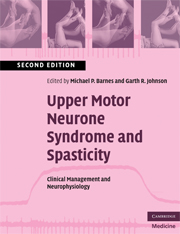Book contents
- Frontmatter
- Contents
- List of Contributors
- Preface to the second edition
- 1 An overview of the clinical management of spasticity
- 2 Neurophysiology of spasticity
- 3 The measurement of spasticity
- 4 Physiotherapy management of spasticity
- 5 Seating and positioning
- 6 Orthoses, splints and casts
- 7 Pharmacological management of spasticity
- 8 Chemical neurolysis in the management of muscle spasticity
- 9 Spasticity and botulinum toxin
- 10 Intrathecal baclofen for the control of spinal and supraspinal spasticity
- 11 Surgical management of spasticity
- 12 Management of spasticity in children
- Index
- References
2 - Neurophysiology of spasticity
Published online by Cambridge University Press: 22 August 2009
- Frontmatter
- Contents
- List of Contributors
- Preface to the second edition
- 1 An overview of the clinical management of spasticity
- 2 Neurophysiology of spasticity
- 3 The measurement of spasticity
- 4 Physiotherapy management of spasticity
- 5 Seating and positioning
- 6 Orthoses, splints and casts
- 7 Pharmacological management of spasticity
- 8 Chemical neurolysis in the management of muscle spasticity
- 9 Spasticity and botulinum toxin
- 10 Intrathecal baclofen for the control of spinal and supraspinal spasticity
- 11 Surgical management of spasticity
- 12 Management of spasticity in children
- Index
- References
Summary
Introduction
The pathophysiology of spasticity is a complex subject and one frequently avoided by clinicians. Some of the difficulties relate to the definition of spasticity and popular misconceptions regarding the role of the pyramidal tracts. On a more basic level, the lack of a very good animal model has been a problem for physiologists. Nonetheless, a clear concept of the underlying neurophysiology will give the clinician better understanding of their patients' clinical features and provide a valuable basis upon which to make management decisions.
Definition
Some of the difficulty that clinicians experience with understanding the pathophysiology of spasticity is due to the definition of this condition. Most textbooks launch the discussion with a definition offered by Lance (1980) and generally accepted by physiologists:
Spasticity is a motor disorder characterized by a velocity-dependent increase in tonic stretch reflexes (‘muscle tone’) with exaggerated tendon jerks, resulting from hyperexcitability of the stretch reflex, as one component of the upper motor neurone syndrome.
It may be difficult for clinicians to correlate this definition with a typical patient. They may see instead a patient with multiple sclerosis who has increased muscle tone in the legs, more in the extensors than the flexors, that appears to increase with the speed of the testing movements. They also recall a clasp-knife phenomenon at the knee, tendon hyperreflexia with crossed adductor reflexes, ankle clonus, extensor plantar responses, a tendency for flexor spasms and, on occasion, extensor spasms.
Keywords
- Type
- Chapter
- Information
- Upper Motor Neurone Syndrome and SpasticityClinical Management and Neurophysiology, pp. 9 - 63Publisher: Cambridge University PressPrint publication year: 2008
References
- 28
- Cited by



